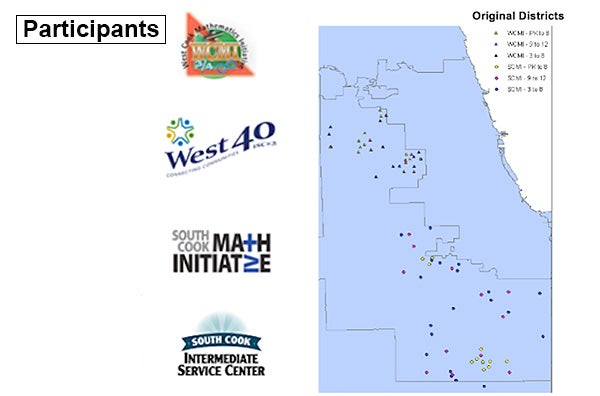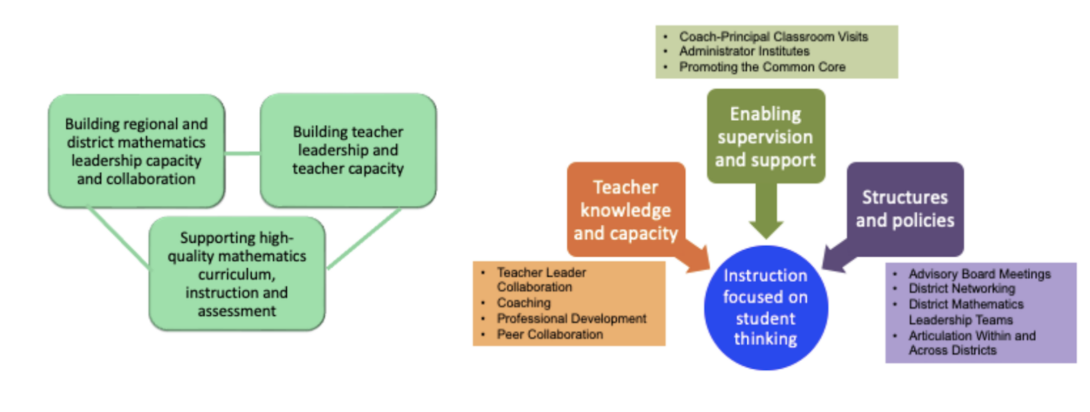History
History
Timeline

MCMI grew out of the work of the Suburban Cook County Mathematics Initiative (SCCMI). SCCMI was established to improve mathematics teaching and learning in grades six through nine.
Participants

Thirty-two school districts with a high percentage of low-income students collaborated with support from the University of Illinois at Chicago and in partnership with the West 40 and South Cook Intermediate Service Centers and funding from The Chicago Community Trust.
Details
project goals

Project Goals:
- To build the capacity of districts and schools to support mathematics improvement efforts and to address the expectations of the Common Core State Standards for Mathematics (CCSS-M);
- To support teachers in implementing high-quality mathematics instruction that is aligned with the CCSS-M; and
- To promote cross-school and cross-district collaboration providing opportunities for every school and district to leverage the shared expertise and to avoid duplication of efforts.
Taken together, these goals helped address mathematics improvement at multiple levels of the school systems as well as leverage resources across participating districts.
A small, coherent set of “big ideas” was emphasized across all professional development offered by the initiative, with implementation of the CCSS-M underlying the work. These included:
- Focusing on student thinking and learning, with rich tasks and formative assessment practices
- Building teacher capacity, attending to content knowledge, resources, and practice
- Enabling effective instruction through structures, policies, and supervision
- Promoting collaboration to support reflection, growth, and sustainability
- Developing a school or district infrastructure—including support for principals and instructional leaders
Outcomes
Outcomes

Increased Opportunities for Professional Development
- Nearly all school leaders engaged in professional learning experiences that built their capacity to support mathematics. Nearly all participating districts indicated on a survey that they are far better prepared to support implementation of the CCSS-M. For instance, one administrator described his experience, stating:
“The administrator PD provided terrific hands-on examples of what an engaged math lesson looks like and the necessity for a pedagogical shift” (Year 5 Teacher Leaders and Administrator Survey Report, 073115, page 53).
Increased Teacher Learning
Teacher pedagogical content knowledge increased as evidenced by results using the Mathematical Knowledge for Teaching Survey. Seventy-five percent of the matched teachers showed gains from the summer of 2011 to January, 2014, with an effect size of 0.76, which is often considered a medium to large magnitude. Such changes are typically correlated with increases in student achievement.
Numerous teachers enrolled in the university courses either to pursue their middle grade mathematics endorsements or master’s degrees in mathematics education.
For more detailed information read the MCMI Historical Summary
Outcomes

Improved School Structures for supporting mathematics
- A majority of the districts established District Mathematics Leadership Teams; collaboration time among mathematics teachers increased in all districts, and that collaboration time was more productive. The amount of mathematics professional development was significantly more than before.
- Districts assigned internal district coaches who developed their capacity through SCCMI professional development and support.
- The average number of minutes spent on mathematics instruction increased.
- Most districts began to use common assessments across classrooms, and most began using CCSS-M aligned instructional materials.